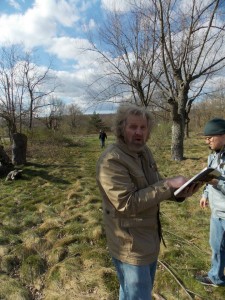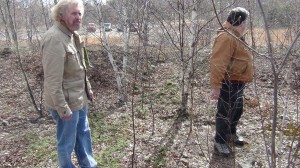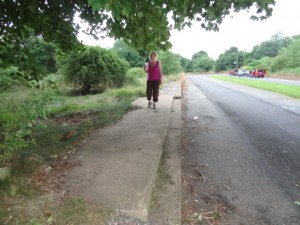
TAG (Theoretical Archaeology Group), University of Illinois at Urbana-Champaign
May 23 – May 25, 2014
Presentation, Session 4: “Gathering Place(s): Locational Convergences of Persons, Practices, and Histories”
Centralia as a Gathering Place
John G. Sabol Jr.
Ghost Excavation Research Center
Most contemporary occupations of ruins are transient presences. There are still other ruins, however, which have become gathering places, involving a recent trend toward so-called “ruin-porn” or “ruin cults”. This is a fascination with abandoned modern ruins, activities taking place there, and a search within them for the uncanny. Aspects of this “ruin porn” can be a part of an archaeology of the contemporary past (Harrison and Schofield 2010), or the use of the archaeological imagination (Shanks 2012).
Archaeology is often fieldwork about destructions. And some of the most expressive material remains are preserved because they have been destroyed by (or were a cause of) fire. Enter Centralia, a site destroyed (directly and indirectly) by an underground coal mine fire, still burning since 1962. What remains of Centralia today has become de-contextualized, moved from one context (sociability) to another (ruination), and still another (an uncanny landscape).
This frequent re-contextualization, in such a short time frame (two decades), is characteristic of an archaeology of the contemporary past. The process of construction, and its contextual destruction, together with associated entanglements, has transformed the Centralia landscape into a popular contemporary gathering place.
Since its forced evacuation in the 1980’s, and the destruction of most of the town’s buildings, Centralia has become a gathering place for “fetishistic veneration”, an experience of place as ruin. Centralia is a “wounded place” (Till 2008). But this type of gathering, both on the surface as material trace, and “buried” within the fictions of popular culture, lies a series of entanglements, a “technology of memory” (Thomas 1993), that require an archaeological disentanglement to engage them. This is a process, an “excavation”, that can separate the layers of past cultural traces, its present “pop culture” manifestations, the natural re-growth of the abandoned landscape, and the prospect of future material remains (the “garbology” of “carnivalesque” contemporary sub-altern behaviors and “legend-tripping”. Today, Centralia has also become a gathering place for storytelling as an altern form of knowledge distribution.
As Tim Ingold (2007) states:
“knowledge is forged in the movement between places, themes, stories, and histories” (2007:84-82).
Storytelling is a social entanglement, a gathering of “themes, stories, and histories”. By discussing Centralia, here and now, one continues in that great tradition of “coal patch” storytellers, as those coal miners once did in Centralia, not so long ago.
The telling of stories becomes an entanglement of relational archaeologies, interactions occurring between material culture (“things”), space, memory, and people. If memory is the archive of that which was performed, embodied in practices that leave signature traces situated in particular spaces. These traces still tell us stories about the entanglement of life and death in Centralia, even in the presence of absence and sociable community-wide gatherings.
In Centralia, the spatial contour of surface remains each gather us within a different story of production (presence) and destruction (absence). This stratigraphy of memory and loss is a palimpsest of coal-mining entanglements or relational genealogies of “excavation” inscription (as new gatherings of “assemblages”) and re-excavated erasures (the replacement of historical social entanglements):
· Some still percolate in the landscape (the coal mine fire);
· Some are “still points” of fragmented presence (traces of walkways; steps; foundations, etc.);
· Some represent loss (absent homes, businesses, sociability);
· Some are transformations (crumbling walls); and
· Some are continuing unaltered presences (the cemeteries).
This has created a heterotopic setting of diverse semiotic expressions, none more notable than the gathering of contemporary “signs” on the “Graffiti Highway”, the “Highway to Hell” (as it is now called) that once led one into Centralia.
We begin to uncover the palimpsest of Centralia stories by “digging” down from the contemporary surface debris and ask ourselves this initial question: Is Centralia an intentional form of “curated ruin”, a site of contemporary destruction that is purposely maintained as a ruined state? And this: is Centralia an example of domicide or “domithanasia” (the accidental or intentional destruction by fire)? Has this “ruined state”, and the doubts about the origin, spread, and mismanagement of the mine fire, created a gathering place of “dark heritage”, an entanglement of myth, folklore, and “legend tripping, entangled in a decades old threat of potential danger?
Has this new social entanglement erased past cultural memories, causing them to disentangle themselves from 150 years of Centralia social history? Does it also raise some serious archaeological questions, principally the natural life-cycle of ruination? By creating uncertainties and tensions within dark, negative images, of a largely absent “technology of memory” (Thomas 1993), what remains of Centralia as a gathering place for coal-mining heritage? Is this absence heritage?
But there is some benefit (and relevance) in gathering to gaze into that ruin of Centralia. There is a resonance with the past. It is looking into the abyss, as a “reverse excavation”: a “dark world” of coal mining turned upside down, unearthed by fire, as the miner’s story is exposed, and becomes part of the landscape presence.
This is an awareness of change, as a “gathering” of contemporary data continues to accumulate through ruination. As Christopher Tilley (1990) states:
“awareness of continual change….a sense of possibility: that the world can be changed upside down….a constant force of dynamism that both spurs creativity and forces and crushes” (1990:128-129). In Centralia, this “reversed excavation”, spurred creativity in a Centralia “para-history”, doing this by crushing the entanglements of a 150 year old coal mining social history.
Yet, this is how the coal miner lived, and what ecological mismanagement of that coal mining left behind: culm banks, stripping holes, forgotten “coal patches”, and abandoned breakers and collieries.
Can we infer (confer) some sense of archaeological meaning in this social ruination and landscape destruction? As we bear witness, those who are gathered here today, we can document some of the fractures that go unobserved in traditional archaeological excavation:
· Why there is an absent subject; and
· What is the absent event.
Here are stories being gathered, taking place (as we can see “live” in this movie clip).
In Centralia, we are all archaeologists (both the professional and the archaeological amateur), as we gather to witness “What happened here! It is here gathering in the ruination, the continuing destruction, and the growth of a new stratigraphy of memory and material remains that are being embedded onto the surface of the landscape. Archaeology is a way of not only witnessing, documenting, and gathering the remains of past social entanglements. It is also a constructive means, a performance practice that can restore memory, making others remember, even in the absence of memorialization (such as the Centralia landscape).
Centralia has become a gathering place for an archaeology of our time:
· Multiple, percolating surface remains of past and present entanglements;
· Enfolding stratas of memory; and a
· Visualization of transformation (the observation of ruination).
And storytelling, together with the gathering of more contemporary “excavating” stories, is still “central” in Centralia today. We must use what remains of history, and what accumulates today as popular culture in those contemporary stories. This is working with the contemporary past:
“Telling stories about the past, about people, places, and things (their entanglements), and sharing them with others is an ontological condition of social life (Edensor 2005:159).
These stories continue the sociability, largely absent today. Centralia, once the “center” in the anthracite coal mining region, a gathering place for an historic “coal rush”, can remain that place of gathering.
The ruination of Centralia reminds us of the ways the past (in this case a coal mining past) comes back to “haunt” us. At the same time, it teaches us why absence is presence, and why it is dominant in this landscape. Today, the ways Centralia spaces con/maintain this past still remind us, in various “assemblages” of visual entanglements, what happened here, after the “gathering” ended. There is no need in Centralia for the use of an archaeological imagination. Its present palimpsest of relational archaeologies is still now being re-written and embedded onto the landscape as we gather here, and the “legend trippers” gather there!!
Only one thing is certain today in Centralia:
The zip code is “ancient” history!
Presentation, Session 5 (concluding comments by the session organizers to follow): “Interpreting the Deep Past: The Convergence of Material Remains, Myth and Memory”
Centralia, Pennsylvania:
The Multiple Entanglements of Layers of Memory
John G. Sabol
Ghost Excavation Research Center
Centralia, Pennsylvania today is a “ghost town”. Since its abandonment in the 1980’s, due to an underground mine fire that has been burning since 1962, the landscape has been transformed into a “curated ruin”: a site of contemporary destruction that is purposely maintained in a “ruined” state. Centralia, once a typical anthracite coal mining community named for its “centralized” location in the anthracite mine fields, has become what Michel de Certeau describes as a place “filled with the presences of absences. What appears designates what is no more…(what) can no longer be seen”.
Centralia, even today, however, still represents a geographical space in the center or “heart” of a coal boom gone bust. I know. I was born and raised not 10 miles away from Centralia. What remains, in the rubble of its destruction, has not disentangled it from its past (often violent) social history. The material, historical, physical, and affective ruptures embodied in trace, fragment, and residual relational entanglements remain, no longer hidden, on the surface of the landscape. This reflects the violence and dislocation of coal mining operations that created its “boom” era and, later, it’s eventual destruction as a vibrant social community.
Centralia was a landscape led by coal mining to ruin long before the fire ended its social existence. Attention here is on “to ruin”, as a still active process. Centralia is not a site in ruin, a desolate, abandoned space that provides a favorable image as a vanished place of past glory. It began as an “underground hell” that has led to a contemporary ruin as a “Hell on Earth”.
What remains in Centralia is not memorialized monuments in ruin, but rather what people are left with: a material culture that indicates blockages of former livelihoods, health and well-being, memory, and a shock to the “afterlife” of structures, sensibilities, and things. This has resulted in a dis-entanglement to history and social life. This has also produced a re-configuration of Centralia’s once “central” position in coal mining economics. Centralia’s ruination is both its state of affairs and the process affecting it. The ruination of Centralia occupies a multi-layered “staged” process:
· Anthracite coal mining was the act of ruining the landscape, seen today in culm banks and “stripping holes” that still surround the “town”;
· Abandoned mine shafts became a condition of being ruined; and the
· Shafts and “stripping holes”, together with the nature of the product (coal) was the cause of the loss of the town’s social character.
Each process, as layered history, has its own temporal dimension, and its particular “technology of memory” (Thomas 1993). The palimpsest of Centralia stratigraphy, because of this process of ruination and destruction, is now exposed on the surface of the landscape.
If archaeology “draws its immense theoretical potential from its study of the materiality of the present….(and) archaeology’s relation to matter leads to a verifiable phenomenology of the present” (Olivier 2013:127), then what remains of Centralia raises a serious archaeological question about the “natural” life-cycle of ruination.
This “phenomenology of the present” at Centralia reveals this surface palimpsest of past histories of social and physical entanglements that have become embedded upon the landscape. Kobialka (2013), in an article entitled, “From Excavation to Archaeological X-Files”, has noted that sometimes there is more to be known from the surface than underneath. This is because the materials (what remains) have surfaced due to post-depositional processes. The “fire” has clearly “excavated” the landscape of Centralia!
And these traces and fragments of what remains “haunt” us with their continued presence in the absence of sustained and sociable “life”. Centralia has become a “landscape of destruction” (cf. Gonzalez-Ruibal 2008). The non-linear strata of material culture that “populates” the surface creates an “immiscible” temporal frame of social, ecological, and structural fractures that reveal an ongoing, unstable, and still “involving” process of layered destruction and accretions of ruination!
With the so-called “turn to things” in the social sciences, how does what remains of Centralia affect – and is affected by- relational archaeologies composed of entanglements between people, space, things, memory, nature, and semiotics? The Centralia “specimens” exhibit subject material found in other archaeological approaches into the contemporary past (ruination, decay, material culture, multiple past vestiges). But there is something else. What is sometimes missing within these archaeologies of the contemporary past is found in numerous examples of contemporary (ever expanding) material cultural semiotics of the Centralia landscape: popular culture. This is another layer of accretion that clearly “haunts” Centralia’s “Graffiti Highway” or the “Highway to Hell”!
Centralia is a contemporary “dumping site” for transient visitations, a place of temporary refuge and permanent refuse for various “carnivalesque” acts of popular “legend-trippers”. What one observes in contemporary material remains (pop culture semiotics and sub-altern behaviors) is a new production and entanglement of space that disengages 150 years of social anthracite coal region history.
In Centralia, there is an abundant mix of the contemporary with the past. These remains of Centralia can be seen as a past that is never simply dead, a present that is continuing to evolve, and a future is further embedded in ruination. This makes Centralia’s past and present very much a integral part of its future.
Today, Centralia occupied a liminal space, betwixt a coal-mining past, a coal-mining burning present, and a myth-building future. Centralia today and tomorrow is (and will be) haunted by this undead evolving character of a new para-history. Its past remains in ruins, its present a ruination, and its future landscape, a “deep map” of those entanglements.
If, as Laurent Olivier states, that archaeology “is an investigation into archives of memory”, then Centralia is a landscape that contains a deep, surface stratigraphy of memory, forming part, I propose, of another contemporary archaeological way of thinking about modern ruination, and a final nod to popular culture. As Dawid Kobialka states in “Nights of the Living Dead: Modern Ruin and Archaeology”:
“Sometimes specifically (an) archaeological approach of material culture still needs references to (a) very non-material domain that is popular culture”.
Sometimes, the fiction that remains, such as those about contemporary Centralia, can preserve, albeit in a different way, an archaeological landscape now characterized by an historical past absence: the social community of Centralia, as a centralized node in a “coal rush” landscape has become a ruined setting of a “Hell on Earth”!
Concluding comments: Excerpts on Session 5regarding John Sabol’s presentation:
Interpreting the Deep Past:
The Convergence of Material Remains, Myth and Memory
written by Thea De Armond and Megan Johanna Daniels (Stanford University, California)
…“In his paper on Centralia, John Sabol laid out for us the sort of absence that suggests myriad narratives – absence that implies a presence – gaps that practically beg to be filled. And the entanglement of absence and presence at a place like Centralia yields ghost stories, urban legends, &c. Centralia’s absent-presence / present-absence, as elaborated by Sabol, does not lend itself to interpretation – to hermeneutics – but it demands something. What do we do, then, with a place like Centralia, when “traditional” archaeological methodologies elude us? Is this still work for archaeologists? …”
Continued comments…
…”John Sabol brings us into our own present with his paper on Centralia. Sabol’s paper got me thinking about cities in general. One of my favourite Radiolab podcasts compared cities to organisms that grow, but, at least in this day and age, usually don’t die, although Centralia was portrayed on this show as an example of a city that did die. Sabol, however, has shown that Centralia is not dead in the sense of gone, finished – it is in a process of ruination that is bundled up with memory, myth, fiction. Things persist even after people have left them, and in their process of ruination, myth (or fiction) preserves, activates, and transforms meaning….”



